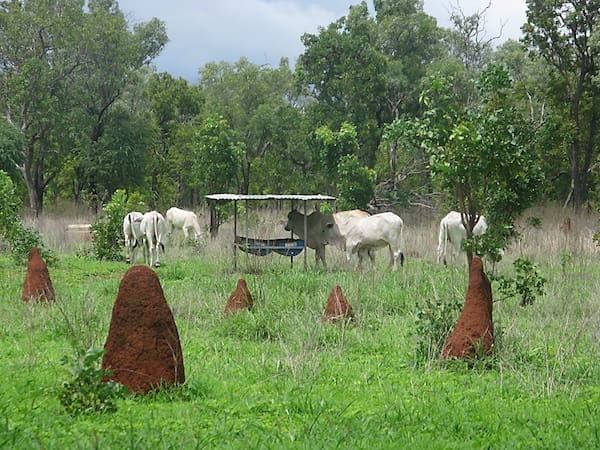
HOMER Simpson once described alcohol as the “cause of, and solution to, all of life’s problems”. Were he not a nuclear power plant operator but a northern beef extension officer instead, he might have applied the same logic to phosphorus.
Phosphorus deficiency has long been a major problem for the northern Australian cattle industry, while an increasing body of research shows that phosphorus supplementation is a major solution.
More industry investment into the problem over the past decade has produced strong practical and economic evidence showing that feeding cattle phosphorus supplements has major benefits for cattle welfare and productivity and business profitability.
To keep producers up to date with what the latest research is showing, and to cut through some of the conflicting information on phosphorus, Meat & Livestock Australia is about to launch an update of its phosphorus manual released 10 years ago.
The new guide will be launched at the North Australia Beef Research Council (NABRC) conference in Darwin from August 22-25.
Beef Central recently caught up with Dr Lindsey Perry, the national project manager for grassfed beef productivity with Meat & Livestock Australia, and a former senior beef extension officer with the Queensland Department of Agriculture and Fisheries based in Cloncurry, to discuss what the new manual will show.
 “It is really a technical manual aimed at beef producers in the north,” Dr Perry told Beef Central.
“It is really a technical manual aimed at beef producers in the north,” Dr Perry told Beef Central.
“We really want to highlight research work that MLA and others have invested in over the last 10 years, and what we now know about phosphorus.
“What the manual should really do is simply help people figure if they have an issue on their property and then give them some ideas on what to do about it and where to go for more information.”
She said there is quite a lot of conflicting information available to producers which makes it quite difficult to understand the issue and take action when and where it is needed.
Understanding of phosphorus management in northern Australia has come a long way since some of the severe problems experienced with phosphorus deficiency over the past century, Lindsey said.
In recent years many northern stockfeed manufacturers have started adding phosphorus to their dry season licks.
“This means that most animals are getting at least some phosphorus across the year, so we don’t see the severity of issues as frequently as we used to,” she said.
“But there is still a lot to do.”
With cattle prices falling, and phosphorus costs still quite high, there is an obvious temptation for producers to consider pulling back on phosphorus supplementation.
“We would say don’t do that, or at least don’t do that without really going through the maths for your specific situation, because in deficient areas the productivity in the herd is so much greater when they have got phosphorus,” she said.
“The weight gain in the steers, the weight gain in the heifers to reach critical mating weight faster, improved breeder body condition score, these benefits flow through to increase conception rate, heavier weaners, lower mortality – it is win-win.
“So try not to cut phosphorus first or at least go through and crunch the numbers before you make a call.”
She said economic analysis produced by Queensland and Northern Territory Departments showed that in heavily deficient areas across the north, a wet season phosphorous lick was where the biggest payback lay.
“That is really where the main bang for your buck is,” she said.
“The dry season lick certainly helps, and in very deficient areas, both, if you can feed a bit all year that is good.”
She said research continues to show a big return on investment when producers starting putting phosphorus into the herd.
“It is fairly rapid payback, I think within one to four years you are going to see weight gain immediately, and in your breeding animals you are going to see more calves and heavier calves in the next couple of seasons provided stocking rates are appropriate and there is feed in front of cattle.
“So it is probably the biggest thing you can do in deficient areas to increase profitability and productivity in the business, and prevent animal health and welfare issues.”
The new manual will be available in printed form, but will also contain QR Codes with links to online resources including an update P Hub on the MLA website which can be viewed here.

Looks to be a good reference manual. However one deficiency is they have only mentioned dry licks. Wet licks I can not find any recipes on.
I know some producers are already set up with mixers and licker rollers for times of drought, sadly information for a wet brew they could mix up for normal times for feeding phosphorus and other elements is impossible to find. The only information seems to be 40 year old drought feeding stuff.
Talk to reseller of wet lick they can custom mix wet licks.
Yes they can, but at a price. And at the moment with cattle prices extremely low compared to the input prices the cost of buying in pre-made licks is high, especially when you consider most have considerable amounts of water in them. So you are buying a lot of water and carting it long distances in a lot of cases
Molasses has risen at least 30% in the last year alone.
A premixed wet product has gone up 60% in the past three years.
A fortified molasses concentrate gone up 50% in the past two years.
With pre-mixed bought in product there is also the problem of too sweet or too sour. Buy in a road train or B-double of pre mix and the cattle start consuming it quickly due to too sweet, you can do a lot of money quickly. There is a lot to be said about being able to mix your own on farm.
All I have seen so far is this youtube video mixing his own. https://www.youtube.com/watch?v=wNdhnBWK-sE